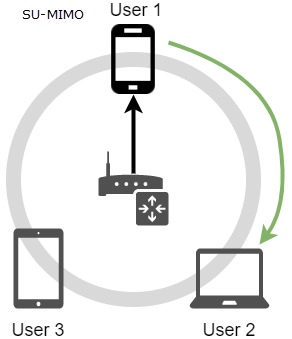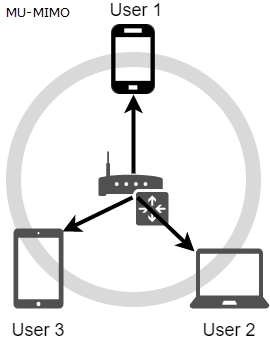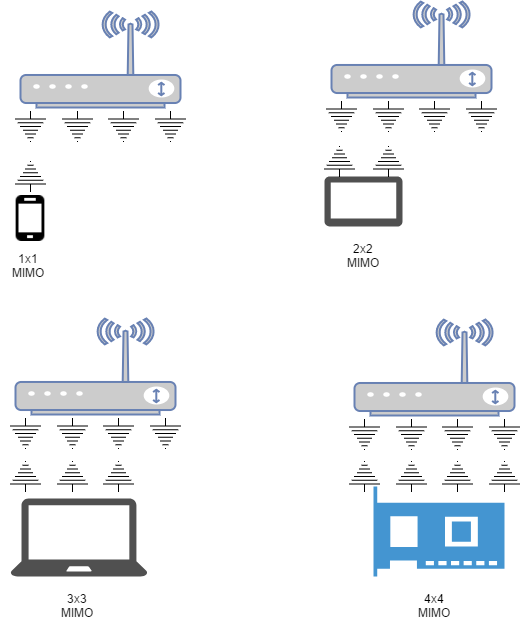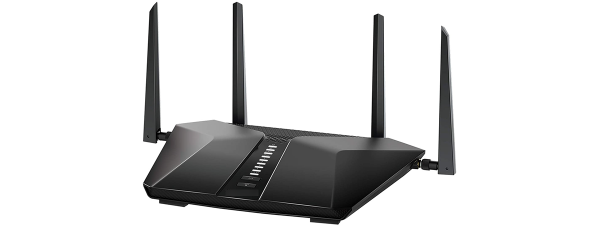
If you study the wireless routers that were launched since the summer of 2015, you notice that most of them advertise a technology called MU-MIMO or Multi-User MIMO and they also promise wireless transfers that are up to four times faster than on traditional routers. What is MU-MIMO except for a funny-sounding acronym that you do not understand? What does MU-MIMO do on your wireless router and should you buy a router with this technology? Read this guide and learn everything you need to know:
How devices connect to wireless routers when using older standards (SU-MIMO or 1x1 MU-MIMO)
Wireless routers that do not offer support for MU-MIMO use the so-called SU-MIMO method for transmitting data over a wireless radio channel. SU-MIMO stands for Single-User Multiple Input Multiple Output, and it means that one wireless channel can send and receive data to and from a network client at a time. SU-MIMO is part of the 802.11n networking standard that was finalized and published in October 2009. All wireless routers with support for the final version of the 802.11n standard can use the SU-MIMO method for transmitting data. When using this approach, routers are good at sending and receiving data, but only in one direction, to one client at a time. If you had a wireless router with one antenna that is used for receiving and sending data, it could connect only to one network device at a time. Let's assume that you have three users, each with their device connected to the WiFi broadcast by the router. The router can send and receive data only to the first user. When it is done with the first user, it goes to the second user and then to the third.
The number of simultaneous data streams is limited by the minimum number of antennas in use. If your router has four antennas, in SU-MIMO, you can have up to four data streams simultaneously. For example, a wireless router that can transmit or receive on two antennas can handle two users simultaneously. A router with four antennas can handle four separate streams and up to four clients simultaneously. Since on many WiFi networks you have multiple wireless clients that are connected, each requesting access to their data stream, the router acts like a machine gun mounted to a merry-go-round. It rattles off bits of data very quickly to multiple devices in turn. Each device waits its turn to send and receive data, so when a new device connects, the line and the wait become longer. Therefore, the more devices you connect to a wireless router that is using SU-MIMO, the bigger the latency becomes and the less speed you get for each device.
NOTE: In some technical documentation, SU-MIMO is referred to as 1x1 MIMO. Keep this in mind when you see 1x1 MIMO being used later in this article.
Here is what MU-MIMO does when it comes to WiFi:
MU-MIMO, Multi-User MIMO or Multi-User Multiple Input Multiple Output is the ability to transmit to several clients simultaneously, instead of just one, or to transfer data to a network client using multiple data streams at once and thus increase the speed of the transfer. With this transfer method, a wireless router can "talk" to more than one user at a time on a single wireless radio channel or to one user using multiple data streams on the same channel.
There are different types of MU-MIMO implementations that are found in wireless routers and devices:
- 2x2 MIMO - it offers two spatial streams of wirelessly transmitting and receiving data on the same channel or frequency. For this implementation, you need only two antennas, and you can simultaneously connect a maximum of two clients, one on each stream.
- 3x3 MIMO - it offers three spatial streams, and you need three antennas. You can simultaneously connect a maximum of three clients.
- 4x4 MIMO - it offers four spatial streams, you need four antennas, and you can connect a maximum of four clients.
- 8x8 MIMO - offers eight spatial streams on the same wireless channel or the same frequency to a maximum of four clients (yes this is correct). For this implementation, you need eight antennas. 8x8 MIMO is not yet a mainstream technology.
In the illustration below you can see a representation of a router with support for 3x3 MIMO, communicating simultaneously with three devices.
What happens when your wireless devices also have support for MU-MIMO?
One aspect of MU-MIMO is that wireless clients can also have support for this technology. Cheap smartphones and tablets have only one wireless antenna to reduce their manufacturing costs, so they offer 1x1 MIMO. Premium smartphones and tablets, often have two antennas and can benefit from 2x2 MIMO. Affordable laptops have two Wi-Fi antennas and can benefit from 2x2 MIMO while more expensive ones have three antennas and can benefit from 3x3 MIMO. The ASUS PCE-AC88 wireless PCI-Express network adapter is the first to implement 4x4 MIMO. Anyone can use it on a desktop computer for WiFi network connections.
The idea behind MU-MIMO is not only to simultaneously connect more devices to the wireless network but also to increase the speed of the wireless connection. Therefore, your network devices offer one of the following MU-MIMO implementations:
- 1x1 MIMO - such devices have one antenna and can connect to only one wireless stream.
- 2x2 MIMO - they have two antennas and can simultaneously connect to two MIMO streams.
- 3x3 MIMO - have three antennas and simultaneously connect to three MIMO streams.
- 4x4 MIMO - have four antennas and simultaneously connect to four MIMO streams.
In your network, you use different types of wireless devices that offer different MIMO implementations. Let's assume that you have a wireless router with 4x4 MIMO. This router provides four data streams. Therefore, you can connect and simultaneously transfer data to four smartphones with 1x1 MIMO because each smartphone uses only one stream. Alternatively, you can connect and simultaneously transfer data to two tablets with 2x2 MIMO, to one laptop with 3x3 MIMO and one smartphone with 1x1 MIMO or just to one device, if it offers support for 4x4 MIMO. However, that device with 4x4 MIMO will have the benefit of transfer speeds that are a lot faster than one smartphone with 1x1 MIMO.
What are the advantages of MU-MIMO?
If you buy a wireless router or mesh WiFi system with support for MU-MIMO transfers, you get the following benefits:
- Decreases the time each device has to wait to receive data
- Increases the download speed offered for all devices that support MU-MIMO wireless streams
- Both devices that support MU-MIMO and the ones that do not, enjoy a better Wi-Fi experience
- Increases network capacity and the number of devices that that router can handle simultaneously
The downsides of MU-MIMO
There are also disadvantages to using wireless mesh systems and routers with MU-MIMO:
- It works only when using the 802.11ac wireless standard and the 5 GHz WiFi frequency. You cannot take advantage of it on the 2.4 GHz frequency and older standards like 802.11n. The 2.4 GHz frequency is stuck with using SU-MIMO.
- MU-MIMO increases only the download speed, not the upload speed.
- You need both a router with MU-MIMO and network devices with MU-MIMO to get faster downloads. When buying new computers, smartphones, and other gadgets, you need to make sure that they work with 802.11ac wireless networks and that they support MU-MIMO transfers.
When was MU-MIMO released?
The MU-MIMO technology is part of the 802.11ac Wave 2 wireless standard, which was issued by the Wi-Fi Alliance in the summer of 2015. In June 2016, the Wi-Fi Alliance extended their Wi-Fi CERTIFIED program to include the specifications from the 802.11ac Wave 2 standard. Wi-Fi Alliance is the worldwide network of companies that bring us wireless products, standards, and technologies. The network includes more than 500 companies, including big names like Cisco, Qualcomm, Microsoft, Dell, Samsung, Apple, Intel and so on.
Do I need MU-MIMO?
Modern homes have an increasing number of smart devices that require constant wireless connectivity. Even if some of your devices do not offer support for MU-MIMO, you still benefit from purchasing a wireless router with MU-MIMO, just because it can handle more devices at once. If you also have premium smartphones, laptops, and consoles in your home, then the benefit of using MU-MIMO increases. We recommend that, if you have eight or more devices that connect to the wireless network in your home, you should consider purchasing a Wi-Fi router with MU-MIMO.
Which wireless routers and mesh WiFi systems support MU-MIMO?
MU-MIMO is offered in all modern wireless routers and mesh WiFi systems, that were released after the 802.11ac Wave 2 standard was finalized in 2015. Here at Digital Citizen, we have tested many MU-MIMO routers and wireless mesh systems. Here are the best that we recommend:
- Premium: ASUS RT-AC86U, ASUS ROG Rapture GT-AC5300, TP-LINK AC3200, TP-LINK Archer C5400, and TP-Link Deco M5
- Mid-range: ASUS Blue Cave, TP-LINK Archer C2600, and Linksys EA7500 v2.
- Low-end: ASUS RT-AC1200G+, TP-Link Archer C1200, and TP-Link Archer C5 v4.
The Wi-Fi Alliance also offers a portal where you can find all devices that provide support for the 802.11ac Wave 2 standard, including wireless routers, smartphones, computers, and tablets. Visit their Product Finder and browse through the types of products that interest you.
What is your experience with MU-MIMO?
You have arrived at the end of this article and, hopefully, we have answered your questions about the MU-MIMO technology. Did you buy a wireless router with MU-MIMO? If you did, what is your experience with it? Did you notice any improvements in the quality of your WiFi experience? Share your thoughts and experiences using the comments form below.










